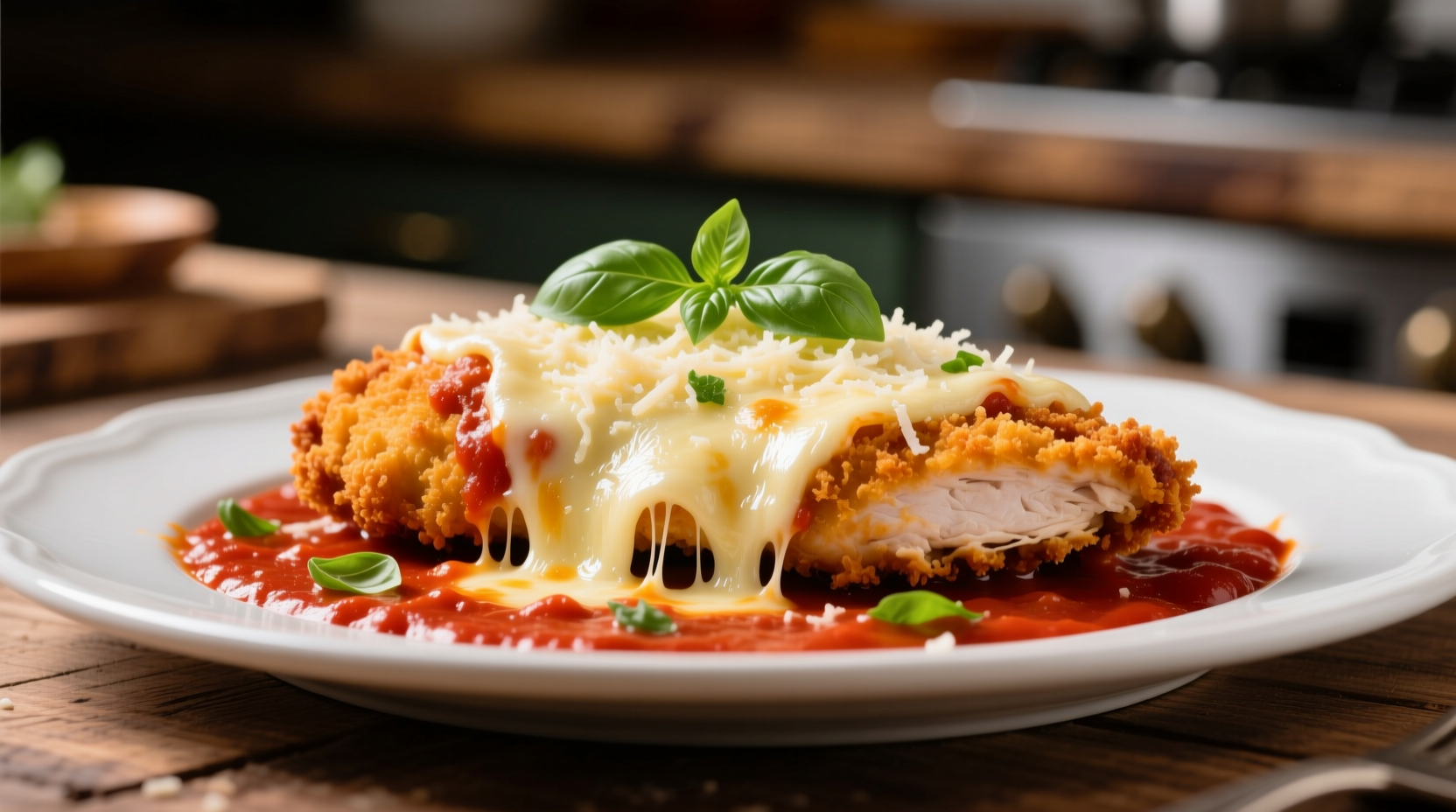The perfect chicken parmesan requires pounding chicken breasts to ½-inch thickness, dredging in seasoned flour, dipping in egg, coating with breadcrumbs, pan-frying until golden, then topping with marinara sauce and melted mozzarella and parmesan cheese before broiling. Total cooking time is 35-40 minutes with preparation taking 15 minutes. Key to success: proper oil temperature (350°F/175°C) for frying and using fresh, high-quality ingredients.
Mastering chicken parmesan means understanding the delicate balance between crispy coating and tender chicken, rich tomato sauce and perfectly melted cheese. This Italian-American classic has evolved from humble Southern Italian roots to become a beloved comfort food across North America. Whether you're cooking for family dinner or special occasions, this guide delivers restaurant-quality results with home kitchen simplicity.
Why This Chicken Parmesan Recipe Works
Unlike many simplified versions that compromise texture or flavor, this method preserves the essential elements that make chicken parmesan exceptional. The three-layer breading technique creates superior crunch that stays crisp even under sauce, while precise oil temperature control prevents greasy results. Following USDA food safety guidelines, we ensure chicken reaches the safe internal temperature of 165°F (74°C) without overcooking.
| Cooking Stage | Temperature | Time | Visual Cues |
|---|---|---|---|
| Frying oil | 350°F (175°C) | N/A | Shimmering, not smoking |
| Chicken frying | 350°F (175°C) | 3-4 minutes per side | Golden brown crust |
| Final bake | Broiler setting | 2-3 minutes | Bubbling cheese, light browning |
Essential Ingredients Checklist
Quality ingredients make the difference between ordinary and extraordinary chicken parmesan. Don't substitute these critical components:
- Chicken breasts: 2 large (6-8 oz each), preferably boneless and skinless
- Breadcrumbs: 1 cup panko (not regular breadcrumbs) for superior crunch
- Cheese: Freshly grated parmesan (not pre-grated) and low-moisture mozzarella
- Marinara sauce: High-quality jarred or homemade (avoid overly sweet varieties)
- Eggs: 2 large, beaten with 1 tablespoon water
- Flour: ½ cup all-purpose, seasoned with garlic powder and dried oregano
According to the FDA's safe minimum internal temperature chart, poultry must reach 165°F (74°C) to eliminate harmful bacteria. Using a digital thermometer ensures safety without drying out the chicken.
Equipment You'll Need
Professional results require the right tools:
- Cast iron or heavy-bottomed skillet (for even heat distribution)
- Meat mallet or rolling pin (for even chicken thickness)
- Three shallow dishes (for breading station)
- Chef's knife and cutting board
- Digital instant-read thermometer

Step-by-Step Cooking Process
Preparation Phase (10 minutes)
- Pound chicken breasts between plastic wrap to ½-inch thickness using a meat mallet
- Season both sides with salt and freshly ground black pepper
- Set up breading station: flour mixture in first dish, beaten eggs in second, breadcrumbs in third
- Heat ½ inch of vegetable oil in skillet to 350°F (175°C)
Breading Phase (5 minutes)
- Dredge chicken in flour, shaking off excess
- Dip in egg mixture, allowing excess to drip off
- Press firmly into breadcrumbs for thorough coating
- Place on wire rack and refrigerate 10 minutes (critical for adhesion)
Cooking Phase (8 minutes)
- Fry chicken in hot oil 3-4 minutes per side until golden brown
- Transfer to paper towel-lined plate to drain excess oil
- Immediately top each cutlet with 2-3 tablespoons marinara sauce
Assembly and Baking (7-10 minutes)
- Top with 1 ounce mozzarella and 1 tablespoon grated parmesan per cutlet
- Bake at 400°F (200°C) for 5 minutes, then broil 2-3 minutes until cheese bubbles
- Rest 3 minutes before serving (allows juices to redistribute)
Critical Success Tips from Professional Kitchens
Professional chefs emphasize these often-overlooked details that transform good chicken parmesan into exceptional:
- Oil temperature control: Maintain 350°F throughout frying using a thermometer. Oil that's too cool makes chicken greasy; too hot burns the coating before chicken cooks through.
- Cheese selection matters: Freshly grated parmesan melts better than pre-grated (which contains anti-caking agents). Low-moisture mozzarella prevents a watery finished dish.
- Resting time is crucial: Allowing chicken to rest after frying prevents steam from making the coating soggy when sauce is added.
- Sauce application technique: Warm your marinara before adding to prevent temperature shock that can make cheese seize up.
According to culinary research from the Culinary Institute of America, the evolution of chicken parmesan from its Italian origins (where eggplant was the traditional base) to American menus demonstrates how immigrant communities adapted recipes using available ingredients while maintaining core preparation techniques.
Serving and Storage Recommendations
For authentic presentation and best eating experience:
- Serve immediately on warm plates with lemon wedges for brightness
- Pair with spaghetti tossed in olive oil or a simple side salad
- Store leftovers in airtight container for up to 3 days
- Reheat in oven at 350°F (175°C) for 10-15 minutes (not microwave)
- Freeze unbaked portions for up to 2 months (thaw before baking)
Common Variations and Customizations
Adapt this classic recipe to suit different dietary needs and preferences:
- Gluten-free: Substitute almond flour and gluten-free breadcrumbs
- Dairy-free: Use nutritional yeast instead of parmesan and vegan cheese
- Lighter version: Bake instead of pan-fry, using egg white wash and reduced cheese
- Spicy kick: Add red pepper flakes to breadcrumbs or use arrabbiata sauce











 浙公网安备
33010002000092号
浙公网安备
33010002000092号 浙B2-20120091-4
浙B2-20120091-4